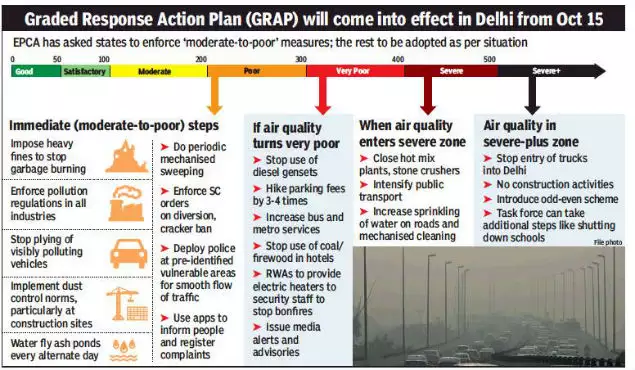Towards cleaner air in Delhi
About Graded Response Action Plan
- It is an emergency plan prepared by the Union Ministry of Environment, Forests & Climate Change (MoEFCC) to contain worsening air quality of Delhi-NCR.
- It was prepared after the order of the Supreme Court in December 2016.
- It comprises a series of measures that come into force incrementally as pollution increases.
- The nature, scope and rigor of measures to be taken is linked to levels of pollution viz. Severe + or Emergency, severe, Very poor, Moderate to poor and Moderate.
- It is implemented by the Environment Pollution (Prevention and Control) Authority (EPCA), which was constituted under the provisions of the Environment (Protection) Act, 1986.
- The actions are to be implemented in the entire National Capital Region (NCR).
- It comprises measures such as prohibition on entry of trucks into Delhi; ban on construction activities, introduction of odd and even scheme for private vehicles, shutting of schools, closure of brick kilns, hot mix plants and stone crushers; shutting down of Badarpur power plant, ban on diesel generator sets, garbage burning in landfills and plying of visibly polluting vehicles etc.

Why in the news?
- Starting October 15, some stricter measures to fight air pollution will come into force in Delhi and its neighbouring National Capital Region (NCR) towns, as part of the Graded Response Action Plan (GRAP).
- The action plan has been in effect for three years in Delhi and NCR.
Need for stricter measures
- Particulate matter, PM2.5 and PM10, exceed national standards and the more stringent World Health Organization limits before COVID-19.
- Delhi’s toxic air also contains high doses of sulphur dioxide and nitrogen oxide.
- The lack of wind worsens the pollutant concentration.
- Delhi needs a 65% reduction to meet the national standards for PM2.5.
- Vehicles, including trucks and two-wheelers, contribute 20%-40% of the PM2.5 concentrations.
Measures to be implemented
- A three-part action comprises emissions standards, public transport, and electric vehicles.
Control emissions
- Stricter enforcement of emission controls and imposing tougher penalties can be a way to reduce pollution. Thus it is dire need to implement the national standards.
Public transport
- Reducing private vehicles on the road by strengthening public transport can be another way.
- Bus Rapid Transit (BRT) systems and the Supreme Court’s ruling to increase Delhi’s bus fleet and align it with the Metro network must be carried out.
- The ‘odd-even’ number plate policy can help, but the system should reduce exemptions, allow a longer implementation period, and complement it with other measures.
Electric vehicles
- Subsidies and investment will be needed to ensure that EVs are used to a meaningful scale, without fossil fuels for charging them.
- The Delhi government’s three-year policy aims to make EVs account for a quarter of the new vehicles registered in the capital by 2024.
Other measures
- Technical solutions need to be underpinned by coordination and transparency across Central, State, and local governments.
- Citizen participation and the media are vital for sharing the message on pollution and health, using data such as those from the Central Pollution Control Board.
Reference:
https://www.thehindu.com/opinion/op-ed/towards-cleaner-air-in-delhi/article32836821.ece
Subscribe
Login
0 Comments
